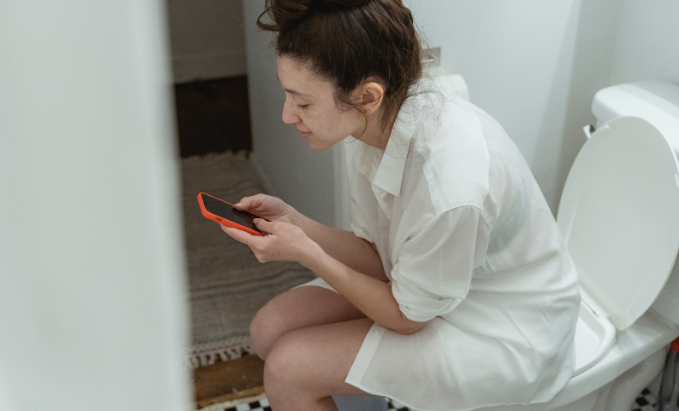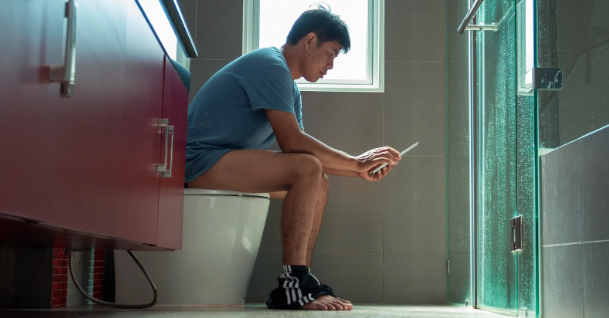These struggling students finally found success in an unlikely place: their phone screens.
Ken Halla was a relatively new high school geography teacher when he got a particularly tough class to teach.
Many of the students were at-risk sophomores who had failed the year before. They were being forced to repeat a class they never cared for in the first place with a bunch of younger kids they didn't know. This didn't make it easy to motivate or engage them.
Making things worse, the school — Hayfield Secondary School in Fairfax County, Virginia — was undergoing major renovations. This meant that most of the freshman classrooms were relocated to mobile trailers during the construction, which was isolating and distracting.
On top of all that, Halla had to deal with a lot of absences. Up to six students could be out at any given time — meaning that he knew it'd be nearly impossible to keep them all on the same page.
"You can’t teach traditionally if they’re not all there, and they’re not there on a regular basis," Halla explains. "So that was kind of my first wake-up call that we can’t do everything the same way."

Halla had to find a way to pass them before they fell even further behind — and to do that, he would need to focus his attention more on individual students.
But there was only one of him and only so much class time to go around. And the more one-on-one time he spent catching up a student, the less he could supervise the rest of the class.
To top it all off, many students were starting to carry smartphones. This made them even more distracted and more inclined to say, "Well, why can't I just Google the answer?"
So finally, Halla dared them to try it.

Halla used his students' smartphones to his own advantage — to keep them engaged while he was helping someone else and to teach them how to work in the real world.
"It was just using the technology to teach differently for different kids, or to have different paces for different kids, or whatever method you needed," he explains.
Halla began to record his lessons, which the students could watch on their phones during class time. During the class period, he would walk around the room to make sure the students stayed on task. He'd check in one-on-one with each of them to offer guidance, answer any outstanding questions, and make sure they were all keeping up — while the other students continued to learn on their own time, at their own pace, with their phones.
Now, if they needed to re-watch a video to understand a concept they didn't get the first time around, they could do that without holding back the rest of the class.
"It’s five minutes long, and [the student's] not embarrassed by asking me 14 questions — or more likely avoiding asking me 14 questions — and she’s getting the material and she’s getting successful," Halla explains. "That’s what counts."

After his early success with that first class, Halla began to explore more ways to integrate video, media, and other smartphone technologies into his classroom.
At first, it was just "Smartphone Fridays."
But soon, he was letting them listen to music in the classroom too — though only if they could show that it was actually making them more productive.
He began to use Remind.com, which schedules, automates, and facilitates text-message tips, reminders, and other help between students and teachers (without actually giving up their personal phone numbers to each other). This kept a written record of assignments and communications that could be sent and received at times when it was effective and convenient — for students and for teachers.
By using technology, Halla had found a way to make teaching more hands-on, blending critical thinking with practical application, all without burdening himself even more. He would eventually come to refer to this approach as "using the cloud to individualize instruction" — which is the subtitle of a book he wrote later on the subject.
Photo by daniel julià lundgren/Flickr.
For Halla's students, classroom tech became their recipe for success by empowering them with responsibility and reward. That little bit of success can go a very long way.
One of Halla's proudest examples involved a student who had relocated to the U.S. from Pakistan just one month before the state exam after his home was destroyed in a flood.
Halla knew that if this new student didn’t pass, it would be yet another burden to weigh down an already difficult year — which, like Halla's sophomores during the school construction, had the potential to snowball into catastrophic results.
But through a combination of interactive videos, online guides, and one-on-one meetings, Halla turned that one long month into an unabashed triumph, setting the student up for a brighter future in his new home country.
“That would’ve never worked in my original class [before I started using technology]," Halla explains. "But because of that, he was able to get the material, he was able to master it, and he was able to make up for a bad year personally with one good result, which was well-deserved."

Technology in the classroom is still a new and changing field, and Halla is careful not to lose focus on the goal: "It all starts with the kids and where they best need to be served."
"We need to evolve and adapt to learning that best fits our kids — not the people serving, teaching, administering, and tutoring the kid," he adds. "If I thought for a second that technology learning was harming or was wrong, then I would be like, 'Nope, experiment failed.' But it doesn't. Thankfully, it helps them."
Recently, Halla left the classroom to start a new position as the e-learning coordinator for the entire Fairfax County public school system, focusing on expanding online classes and working with other teachers to integrate video, smartphones, and individualized cloud learning into their curriculums.
Once again, he’s seen tremendous results: enrollment is up and AP scores are already higher than the country’s average. Most importantly, the students are finding greater success in ways that work for them.



 In a 4-day model, kids often (but not always) receive less instructional time. Photo by
In a 4-day model, kids often (but not always) receive less instructional time. Photo by 


 A woman looking at her phone on the toilet.via
A woman looking at her phone on the toilet.via  A man looking at his phone on the toilet.via
A man looking at his phone on the toilet.via 